 W
WAlice's Adventures in Wonderland is an 1865 novel by English author Lewis Carroll. It tells of a young girl named Alice, who falls through a rabbit hole into a subterranean fantasy world populated by peculiar, anthropomorphic creatures. It is considered to be one of the best examples of the literary nonsense genre. The tale plays with logic, giving the story lasting popularity with adults as well as with children.
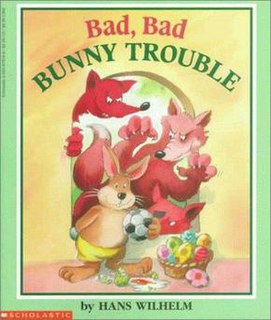 W
WBad, Bad Bunny Trouble is a 1994 children's picture book written and illustrated by Hans Wilhelm. It is the second book of the Bunny Trouble trilogy, a series about Ralph, a soccer-loving rabbit who frequently causes trouble with his family and friends. It is preceded by Bunny Trouble and followed by More Bunny Trouble.
 W
WBruh Rabbit and the Tar Baby Girl is a 2003 picture book by Virginia Hamilton and illustrated by James Ransome. It is a retelling by Hamilton, in the Gullah dialect, of the classic story of Bruh Rabbit outwitting Bruh Wolf.
 W
WBunnicula: A Rabbit-Tale of Mystery is a children's novel written by Deborah Howe and James Howe, illustrated by Alan Daniel, and published by Atheneum Books in 1979. It inaugurated the Bunnicula series and Bunnicula universe. Based on a 2007 online poll, the National Education Association listed the novel as one of the "Teachers' Top 100 Books for Children." The series chronicles the adventures of the Monroe family and their pets, Harold the dog, Chester the cat, and Bunnicula the rabbit. The novels are narrated by Harold the family dog.
 W
WCecily Parsley's Nursery Rhymes is a children's book written and illustrated by Beatrix Potter, and published by Frederick Warne & Co. in December 1922. The book is a compilation of traditional nursery rhymes such as "Goosey Goosey Gander", "This Little Piggy" and "Three Blind Mice". It was Potter's second book of rhymes published by Warne. Merchandise generated from the tale includes Beswick Pottery porcelain figurines and Schmid music boxes.
 W
WThe Constant Rabbit is a 2020 science fantasy allegorical novel by Jasper Fforde. It was published by Hodder & Stoughton.
 W
WCreepy Carrots! is a 40-page children 's picture book written by Aaron Reynolds and illustrated by Peter Brown. It was published on August 21, 2012 by Simon & Schuster Books for Young Readers.
 W
WA Day in the Life of Marlon Bundo is a 2018 children's book written by Jill Twiss and illustrated by EG Keller. The book is about a fictional day in the life of Marlon Bundo, the real-life pet rabbit of former Vice President of the United States Mike Pence, and details the same-sex romance between Marlon Bundo and another rabbit named Wesley. It is a loose parody of Marlon Bundo's A Day in the Life of the Vice President, another children's book featuring Marlon Bundo written by Charlotte Pence and illustrated by Karen Pence.
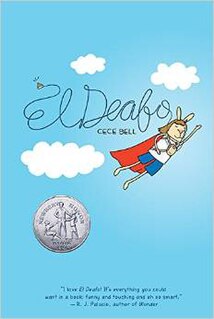 W
WEl Deafo is a graphic novel written and illustrated by Cece Bell. The book is a loose autobiographical account of Bell's childhood and living with her deafness. However, the characters in the book are all bunnies. Cece Bell, in an interview with the Horn Book Magazine, states "What are bunnies known for? Big ears; excellent hearing," rendering her choice of characters and their deafness ironic.
 W
WFifteen Rabbits is a 1929 survival and adventure novel by the Austrian writer Felix Salten. The novel depicts a year in the life of a colony of rabbits in the same forest that Bambi dwells.
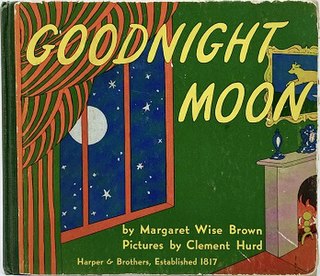 W
WGoodnight Moon is an American children's book written by Margaret Wise Brown and illustrated by Clement Hurd. It was published on September 3, 1947, and is a highly acclaimed bedtime story.
 W
WGuess How Much I Love You is a British children's book written by Sam McBratney and illustrated by Anita Jeram, published in 1994, in the United Kingdom by Walker Books and in 1995, in the United States by its subsidiary Candlewick Press. The book was a 1996 ALA Notable Children's Book. According to its publishers, in addition to the ALA award and numerous other awards, it has sold more than 43 million copies worldwide and been published in 57 languages.
 W
WKnuffle Bunny: A Cautionary Tale (k-nuffle) is a children's picture book by Mo Willems. Released by Hyperion Books in 2004, Knuffle Bunny won the 2005 Caldecott Honor. The story spawned an animated short film and a musical play, as well as two sequels. The Knuffle Bunny Series has sold more than 750,000 copies. The series' protagonist, Trixie, is named after Willems's real-life child.
 W
WKnuffle Bunny Free: An Unexpected Diversion is a children's picture book by author and illustrator Mo Willems. It was released on September 28, 2010 by Balzer + Bray, an imprint of HarperCollins. It is the third and final book in Willem's Knuffle Bunny series, which also includes Knuffle Bunny: A Cautionary Tale and Knuffle Bunny Too: A Case of Mistaken Identity. It debuted at the number one spot on The New York Times Best Seller list. Amazon.com named the book one of its Top 10 Children's Picture Books of 2010. Willems was a finalist for Illustrator of the Year during 2011's Children's Book Week, sponsored by the Children's Book Council of the United States because of his efforts in illustrating this book.
 W
WKnuffle Bunny Too: A Case of Mistaken Identity is a children's picture book by Mo Willems. A sequel to Knuffle Bunny: A Cautionary Tale, it was released on September 4, 2007 and reached the number one spot on the New York Times Bestseller List for children's books.
 W
WMarlon Bundo's A Day in the Life of the Vice President is a 2018 children's book by Charlotte Pence as author and Karen Pence as illustrator. It details a fictional day in the life of Marlon Bundo, pet rabbit of Vice President of the United States Mike Pence, father of Charlotte and husband of Karen. It received lukewarm reviews from professional critics, who praised the illustrations but found fault with the prose.
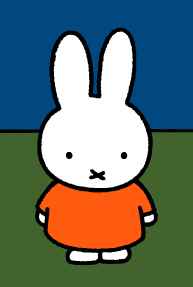 W
WMiffy is a small female rabbit in a series of picture books drawn and written by Dutch artist Dick Bruna. The original Dutch name, "nijntje", is a shortening of the diminutive konijntje, "little rabbit".
 W
WThe Miraculous Journey of Edward Tulane is a 2006 novel by Kate DiCamillo. Following the life of a china rabbit, the book won the 2006 Boston Globe-Horn Book Award in Fiction category.
 W
WMr. Rabbit and the Lovely Present, written by Charlotte Zolotow and illustrated by Maurice Sendak, is a 1962 pictures book published by HarperCollins. It was a Caldecott Medal Honor Book for 1963 and was one of Sendak's Caldecott Honor Medal of a total of seven during his career. Sendak won the Caldecott Medal in 1964 for Where the Wild Things Are, which he both authored and illustrated. Mr. Rabbit and the Lovely Present was re-issued by HarperCollins in 1999 in hardcover format as part of a project to re-issue 22 Sendak works, including several authored by Zolotow.
 W
WMy World is an American children's picture book written by Margaret Wise Brown and illustrated by Clement Hurd. The third book in Brown and Hurd's "classic series", it is the "companion" to Brown & Hurd's Goodnight Moon. My World was published in December 1949.
 W
WNight Fall in the Ti-Tree is a 1905 artist's book by Violet Teague and Geraldine Rede. It is about a family of rabbits and is known as the first Australian work using colour relief printing.
 W
WNot a Box is a children's book by Antoinette Portis.
 W
WPat the Bunny is a "touch and feel" book for small children and babies and has been a perennial best-seller in the United States since its publication in 1940. It is not a book in the traditional sense, but more a collection of things to do, such as pat the fake fur of a rabbit on one page, feel a bit of sandpaper that stands for "daddy's scratchy face" on another, and look in a mirror on yet another.
 W
WPeriwinkle at the Full Moon Ball is the first book in the Beechwood Bunny Tales series. It was originally published by France's Éditions Milan in 1987, and in the United States by Gareth Stevens in 1991. In its native country, the book won the Prix Saint-Exupéry for 1988, and the Prix de la Ville de Paris for its author.
 W
WRabbit and the Moon is a 1998 book by Douglas Wood. It is an adaption of a Cree legend about how Rabbit reached the Moon, and how the Whooping crane got its long legs and red head marking.
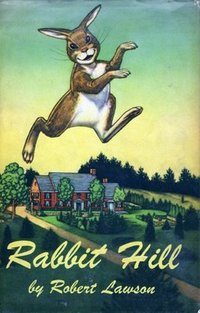 W
WRabbit Hill is a children's novel by Robert Lawson that won the Newbery Medal for excellence in American children's literature in 1945.
 W
WRabbit Makes a Monkey of Lion: A Swahili Tale is a 1989 children's picture book by Verna Aardema and illustrated by Jerry Pinkney. It is an adaption of a Swahili folktale and is about Rabbit tricking Lion over a calabash tree.
 W
WThe Rabbits' Wedding is a children's picture book created and illustrated by American author and illustrator Garth Williams, who came to the fore as a writer after his success as an illustrator with Stuart Little. The Rabbits' Wedding was published on April 30, 1958, and depicted the love affair and wedding of two bunnies, one white and one black. The following year it became the center of a controversy in the state of Alabama when Edward Oswell Eddins, State Senator from Marengo County, claimed the book was "propaganda for integration and intermarriage". Alabama's State Library Agency director, Emily Wheelock Reed, faced censorship challenges over the book at the height of the Civil Rights Movement in the American South.
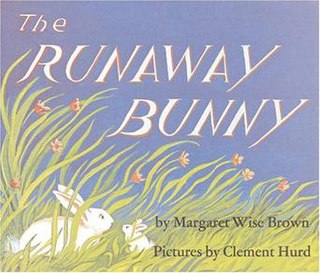 W
WThe Runaway Bunny is a 1942 picture book written by Margaret Wise Brown and illustrated by Clement Hurd. The plot deals with a small rabbit, who wants to run away. His mother, however, tells him that "if you run away, I will run after you."
 W
WThe Silly Book is a children's book by Stoo Hample, first published in 1961 and reissued in 2004. It includes silly songs, silly names to call people and things, silly recipes, silly poems, silly things to say, and "silly nothings". Hample's first book, it was originally edited by Ursula Nordstrom. It has been described as "a classic pastiche of poems, songs, jokes, drawings and goofy remarks", as a book that "defies categorization", and as "the literary equivalent of a child's giggle fit" and "a humor reference point for countless knee-high baby boomers."
 W
WA Starlit Somersault Downhill is a 1993 book by Nancy Willard and illustrator Jerry Pinkney about a rabbit that is invited by a bear to share a cave over winter but instead of hibernating decides to enjoy the outside.
 W
WThe Story of A Fierce Bad Rabbit is a children’s book written and illustrated by Beatrix Potter, and first published by Frederick Warne & Co. in December 1906. The book tells of a bad little rabbit who is fired upon by a hunter and loses his tail and whiskers. The book was intended for babies and very young children, and was originally published on a strip of paper that folded into a wallet and was tied with a ribbon. The format was unpopular with booksellers, and eventually reprinted in the standard small book format of the Peter Rabbit library. Although the book sold well, there are not many left in existence. It provides the young child with an introduction to books and the Peter Rabbit universe.
 W
WThe Tale of Benjamin Bunny is a children's book written and illustrated by Beatrix Potter, and first published by Frederick Warne & Co. in September 1904. The book is a sequel to The Tale of Peter Rabbit (1902), and tells of Peter's return to Mr. McGregor's garden with his cousin Benjamin to retrieve the clothes he lost there during his previous adventure. In Benjamin Bunny, Potter deepened the rabbit universe she created in Peter Rabbit, and, in doing so, suggested the rabbit world was parallel to the human world but complete and sufficient unto itself.
 W
WThe Tale of Mr. Tod is a children's book written and illustrated by Beatrix Potter, first published by Frederick Warne & Co. in 1912. The tale is about a badger called Tommy Brock and his arch enemy Mr. Tod, a fox. Brock kidnaps the children of Benjamin Bunny and his wife Flopsy, intending to eat them, and hides them in an oven in the home of Mr. Tod. Benjamin and his cousin Peter Rabbit have followed Tommy Brock in an attempt to rescue the babies. When Mr. Tod finds Brock asleep in his bed, he determines to get him out of the house. His initial attempt fails, and the two eventually come to blows. Under cover of the fight, the rabbits rescue the baby rabbits. The tale was influenced by the Uncle Remus stories, and was set in the fields of Potter's Castle Farm. Black and white illustrations outnumber those in colour. The tale is critically considered one of Potter's "most complex and successful in plot and tone."
 W
WThe Tale of Peter Rabbit is a children's book written and illustrated by Beatrix Potter that follows mischievous and disobedient young Peter Rabbit as he gets into, and is chased around, the garden of Mr. McGregor. He escapes and returns home to his mother, who puts him to bed after offering him chamomile-tea. The tale was written for five-year-old Noel Moore, son of Potter's former governess Annie Carter Moore, in 1893. It was revised and privately printed by Potter in 1901 after several publishers' rejections, but was printed in a trade edition by Frederick Warne & Co. in 1902. The book was a success, and multiple reprints were issued in the years immediately following its debut. It has been translated into 36 languages, and with 45 million copies sold it is one of the best-selling books in history.
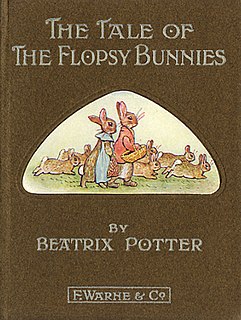 W
WThe Tale of The Flopsy Bunnies is a children's book written and illustrated by Beatrix Potter, and first published by Frederick Warne & Co. in July 1909. After two full-length tales about rabbits, Potter had grown weary of the subject and was reluctant to write another. She realized however that children most enjoyed her rabbit stories and pictures, and so reached back to characters and plot elements from The Tale of Peter Rabbit (1902) and The Tale of Benjamin Bunny (1904) to create The Flopsy Bunnies. A semi-formal garden of archways and flowerbeds in Wales at the home of her uncle and aunt became the background for the illustrations.
 W
WTales from Watership Down is a collection of 19 short stories by Richard Adams, published in 1996 as a follow-up to Adams's highly successful 1972 novel about rabbits, Watership Down. It consists of a number of short stories of rabbit mythology, followed by several chapters featuring many of the characters introduced in the earlier book. Like its predecessor, Tales from Watership Down features epigraphs at the beginning of each chapter and a Lapine glossary.
 W
WThe Tales of Uncle Remus: The Adventures of Brer Rabbit is a 1987 Children's book by Julius Lester and illustrator Jerry Pinkney. It is a retelling of the American Br'er Rabbit tales.
 W
WThe Tortoise & The Hare is a 2013 wordless picture book of Aesop's classic fable and is illustrated by Jerry Pinkney. It is about a tortoise and a hare that compete in a foot race with the tortoise surprisingly winning.
 W
WThe Velveteen Rabbit is a British children's book written by Margery Williams and illustrated by William Nicholson. It chronicles the story of a stuffed rabbit's desire to become real through the love of his owner. The book was first published in 1922 and has been republished many times since.
 W
WWatership Down is an adventure novel by English author Richard Adams, published by Rex Collings Ltd of London in 1972. Set in southern England, around Hampshire, the story features a small group of rabbits. Although they live in their natural wild environment, with burrows, they are anthropomorphised, possessing their own culture, language, proverbs, poetry, and mythology. Evoking epic themes, the novel follows the rabbits as they escape the destruction of their warren and seek a place to establish a new home, encountering perils and temptations along the way.
 W
WWho Censored Roger Rabbit? is a mystery novel written by Gary K. Wolf in 1981. It was later adapted by Disney and Amblin Entertainment into the critically acclaimed 1988 film Who Framed Roger Rabbit.
 W
WThe Wind in the Willows is a children's book by Scottish novelist Kenneth Grahame, first published in 1908. Alternatingly slow moving and fast paced, it focuses on four anthropomorphised animals: Mole, Rat, Toad, and Badger. They live in a pastoral version of Edwardian England.
 W
WWolves is picture book written and illustrated by Emily Gravett, published by Macmillan in 2005. Her first book, it won the annual Kate Greenaway Medal from the Chartered Institute of Library and Information Professionals as the year's best-illustrated children's book published in the United Kingdom. It was also bronze runner-up for the Nestlé Smarties Book Prize in age category 0–5 years.
 W
WThe Year of the Angry Rabbit is a science fiction novel by Australian author Russell Braddon, in which giant mutant rabbits run amok in Australia while the Prime Minister uses a new superweapon to dominate the planet.
 W
WThe Year of the Hare is a 1975 picaresque novel by Finnish author Arto Paasilinna. It tells the story of Kaarlo Vatanen, a frustrated journalist, who, after nearly killing a hare with his car, turns away from an unhappy and unwholesome life. On an impulse, Vatanen abruptly abandons his urban lifestyle, job, and wife, in exchange for the freedom of the road and the wilderness, living off his cash savings and casual employment, all the time accompanied by the hare which he has nursed back to health and kept as a pet. A year of unlikely encounters and adventures ensues, during the course of which Vatanen repeatedly runs afoul of the law and conventional mores but manages to stay afloat thanks to the help and understanding of other sympathetic free spirits.
 W
WZomo The Rabbit is a 1992 book by Gerald McDermott based on a Nigerian folktale that explains why the rabbit runs so fast from other animals.